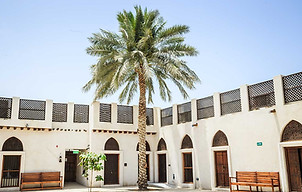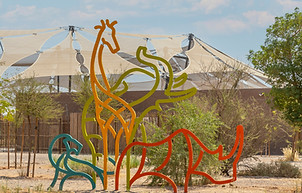Sharjah is the third largest emirate in the UAE, while Ajman is the smallest. Sharjah is a land with architectural heritage and cultural wealth, with several heritage areas, arts and cultural spaces. Ajman is known for its traditional charm and its beaches, while it also features the rugged Hajjar mountain range.

Heart Of Sharjah
Once the hub of Sharjah’s merchant trade, the original city centre has been reborn as a vibrant heritage and arts district. It is characterized by its well-preserved traditional architecture, narrow alleyways, and bustling souks, providing visitors with a glimpse into the past. The Heart of Sharjah is home to heritage buildings, museums, art galleries, and cultural attractions.

Cultural Square
Featuring a 14-metre high pedestal with a sculpture of the Holy Quran as the centrepiece of the roundabout in the square, it represents the spiritual heart of the city. The sculpture, which was designed by Spanish sculptor Marinas Rubias, is encircled by stately buildings which are of prominence in UAE history, particularly the Ruler’s Office and the Ahmad Bin Hanbal Mosque.

Sharjah Museum of Islamic Civilization
Housed within a beautifully restored traditional souq building, the museum showcases the rich artistic, scientific, and cultural achievements of the Islamic world. Visitors can explore a vast collection of artifacts, manuscripts, and artworks that span over 1,400 years of Islamic history, including stunning examples of calligraphy, ceramics, textiles, and scientific instruments.

House of Wisdom
The pioneering cultural institution is dedicated to fostering knowledge, innovation, and creativity. It features state-of-the-art facilities, including libraries, laboratories, exhibition spaces, and collaborative workspaces, designed to inspire curiosity and facilitate interdisciplinary exploration.

Bait Al Naboodah Museum
Housed within the beautifully restored residence of the prominent Al Naboodah family, the museum offers visitors a glimpse into the traditional Emirati way of life during the 19th and early 20th centuries. Exhibits within the museum showcase the family's rich heritage, including their role in trade, pearl diving, and the development of the region.

Souq Al Jubail
Located just off the Sharjah, it stands as a landmark with domes and pillars that are traditional to Islamic architecture. Fish are hauled in from nearby boats, making the souk the quintessential Sharjah fish market. Souq Al Jubail is a perfect example of shopping in the UAE culture, with many locals talking to the grocers at each stall to find the best produce at the best price.

Souq Al Arsah
An erstwhile marketplace for traders from Persia, India and Bedouin tribes, the souk is now a covered market with air-conditioned alleyways featuring solid wooden doors, beautiful coral brick walls and hanging lanterns that symbolise UAE culture. The quaint stores sell everything from pearl chests and copper coffee pots to jewellery, abayas and kandooras.

Sharjah Desert Park
Home to Arabia's Wildlife Centre, which houses a diverse collection of indigenous Arabian wildlife, including endangered species such as Arabian leopards and oryx. Additionally, it features the Children's Farm, where families can interact with domestic animals and learn about traditional farming practices, as well as the Sharjah Natural History and Botanical Museum.

Al Noor Island
Spanning over 45,000 square meters, the Island is a haven for nature lovers, with its diverse botanical gardens showcasing a rich variety of plants and trees. The island also features the award-winning Butterfly House, home to hundreds of colourful butterflies from around the world.

Ajman National Museum
Housed in the Ajman Fort that dates back to the 18th-century, the museum showcases artifacts, exhibits, and interactive displays that highlight Ajman's traditions, customs, and development. Visitors can explore the museum's galleries, learn about the region's maritime history, and gain insights into Ajman's role in the United Arab Emirates.



